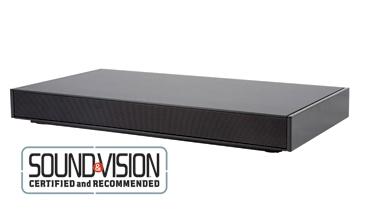Zvox Z-Base 550 TV sound system

The Short Form |
| $499 / ZVOXAUDIO.COM |
Snapshot |
| The Zvox Z-Base 500 is the best solution to date for simple home theater sound - one that everyone in the family can easily use and enjoy |
Plus |
| • Good dialogue reproduction • Convincing surround effect • Possibly the only home theater audio system an average person could figure out |
Minus |
| • Hard-to-gauge adjustment levels • Sounds a little quiet with some Dolby Digital 5.1 soundtracks |
Key Features |
| • (5) 2-in midrange/tweeters, 5½-in woofer • 60 watts total power • (2) stereo audio inputs; subwoofer output • 3½ x 28 x 14½ in, 19 lb |
A writer once said, "From economy springs simplicity, and from simplicity springs happiness." Confirmation of this adage abounds. Consider empty nesters, who often trade in expensive, sprawling homes for cozier, easier-to-maintain cottages. Consider Japan's Lost Decade, in which a stalled financial system inspired a workaholic populace to abandon crazed materialism and expand their starved emotional lives.
So who came up with this profound proverb? Emerson? Nope. Thoreau? Nope. Actually, it was Butterworth - that is, me. But any acclaim should go to the object that inspired my insight: Zvox's Z-Base 550, an affordable home theater sound system that's so simple it might be impossible to mess up. This 31?2-inch-high box is meant to fit right under the base of a flat-panel TV, yet it incorporates all the speakers and amplifiers you need for home theater sound. And the Z-Base works as if it were built into your TV.
The magic lies in the Z-Base's minimalism. It connects to the variable-level audio outputs of a TV, so the TV's volume up/down buttons will control the Z-Base's volume level. You plug your source devices - such as a DVD player or a cable box - into the TV, and the TV routes the sound to one of the Z-Base's two stereo analog-audio inputs.
The front of the unit has five 2-inch drivers, with three grouped side-by-side in the middle. All three get a mono signal, a combination of the left and right channels. The center driver gets the full spectrum of midrange and treble, while the drivers immediately flanking it receive a little less treble, in order to keep them from interfering with the center driver.
The remaining 2-inch drivers are positioned at the far left and right of the front baffle. The far-left driver gets the full left-channel signal, plus a phase-inverted and frequency-filtered version of the right-channel signal. The far-right driver gets the full right-channel signal plus an inverted/filtered version of the left-channel signal. The resulting mix of these out-of-phase, filtered signals tricks your brain into thinking it's hearing sound from several feet to the left and right of the Z-Base - and even from the sides of the room and behind your head.
Lots of manufacturers have used this "crosstalk cancellation" technique over the years, perhaps most notably Polk with its Stereo Dimensional Array technology. Zvox's name for it is PhaseCue. The company's president, Tom Hannaher, says PhaseCue's "secret sauce" is the amount of opposite-channel signal that's mixed in, and the way in which it's filtered.
A woofer on the bottom provides bass. Zvox includes a tiny remote that controls power, volume, mute, PhaseCue level, woofer level, and treble. If your TV has variable audio output, you'll only need this remote for setup and occasional tweaking. There's also a subwoofer output (a full-range mono signal) for those who demand even more bass.
SETUP
From a physical standpoint, installation of the Z-Base couldn't be much simpler: Just stick it under your TV. Zvox says the Z-Base will support most 32- to 47-inch TVs, but you can go bigger as long as the TV weighs less than 90 pounds. Because the box's front is nearly featureless, it looks like part of the furniture.
Hookup is just as easy: Connect the included pair of audio cables from the TV's variable-audio output to either of the Z-Base's inputs. According to Hannaher, the second input is mainly intended for use with an iPod or other digital music player.
There's no display on the front, just a single blue LED. It's easy to adjust the volume, PhaseCue, woofer, and treble by ear, but finding out what settings you're using is tougher. The blue LED blinks when you hit a button on the remote. But when you get to the bottom or the top of the adjustment scale, the LED stops blinking. There are nine adjustment steps for PhaseCue, woofer, and treble. So you can run each adjustment all the way down, then count the number of times you hit the button on the remote.
The PhaseCue control adjusts the balance between the center and the left and right drivers. Turn it all the way down, and almost all of the sound will come from the center speakers. Turn it full up, and you'll get an extreme, unnatural-sounding surround effect. As you turn the effect up, it can start to drown out the dialogue coming from the center speakers. With a receiver, you can calibrate this balance so you know it's right. With the Z-Base, you have to trust your ears.
- Log in or register to post comments




















































